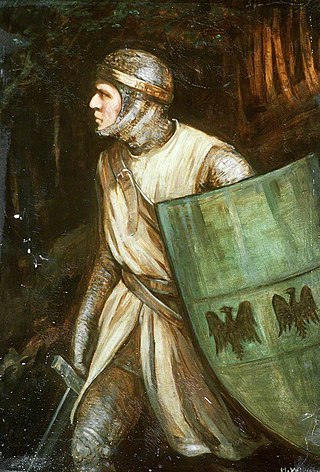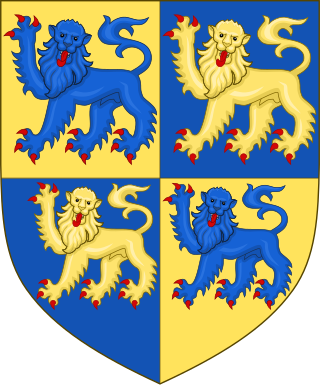Related Research Articles

Llywelyn ap Gruffudd, Llywelyn II, also known as Llywelyn the Last, was Prince of Gwynedd, and later was recognised as the Prince of Wales from 1258 until his death at Cilmeri in 1282. Llywelyn was the son of Gruffudd ap Llywelyn ap Iorwerth and grandson of Llywelyn ab Iorwerth, and he was one of the last native and independent princes of Wales before its conquest by Edward I of England and English rule in Wales that followed, until Owain Glyndŵr held the title during the Welsh Revolt of 1400–1415.

Owain ap Gruffudd was King of Gwynedd, North Wales, from 1137 until his death in 1170, succeeding his father Gruffudd ap Cynan. He was called Owain the Great and the first to be styled "Prince of Wales" and the "Prince of the Welsh". He is considered to be the most successful of all the North Welsh princes prior to his grandson, Llywelyn ab Iorwerth. He became known as Owain Gwynedd to distinguish him from the contemporary king of Powys Wenwynwyn, Owain ap Gruffydd ap Maredudd, who became known as Owain Cyfeiliog.

Princess of Wales is a title used since the 14th century by the wife of the Prince of Wales. The Princess is a likely future queen consort, as "Prince of Wales" is a title reserved by custom for the heir apparent to the British throne, and earlier the English throne. The current title-holder is Catherine.

The Kingdom of Gwynedd was a Welsh kingdom and a Roman Empire successor state that emerged in sub-Roman Britain in the 5th century during the Anglo-Saxon settlement of Britain.
Gwenllian of Wales or Gwenllian ferch Llywelyn was the daughter of Llywelyn ap Gruffudd, the last native Prince of Wales. Gwenllian is sometimes confused with Gwenllian ferch Gruffudd, who lived two centuries earlier.
Hywel ab Owain Gwynedd, King of Gwynedd in 1170, was a Welsh poet and military leader. Hywel was the son of Owain Gwynedd, king of Gwynedd and an Irishwoman named Pyfog. In recognition of this, he was also known as Hywel ap Gwyddeles. Hywel is also known as the Poet Prince for his bardic skills.
Rhodri ap Gruffudd was the third or fourth son of Gruffydd ap Llywelyn Fawr. He was the younger brother of both Llywelyn ap Gruffudd of Gwynedd, Prince of Wales) and of Owain Goch ap Gruffydd. He was probably the younger brother of Dafydd ap Gruffydd of Gwynedd but may have been the older as there are no accurate records of their birth dates.

Powys Wenwynwyn or Powys Cyfeiliog was a Welsh kingdom which existed during the high Middle Ages. The realm was the southern portion of the former princely state of Powys which split following the death of Madog ap Maredudd of Powys in 1160: the northern portion (Maelor) went to Gruffydd Maelor and eventually became known as Powys Fadog; while the southern portion (Cyfeiliog) going to Owain Cyfeiliog and becoming known, eventually, as Powys Wenwynwyn after Prince Gwenwynwyn ab Owain, its second ruler.

Castell y Bere is a Welsh castle near Llanfihangel-y-pennant in Gwynedd, Wales. Constructed by Llywelyn the Great in the 1220s, the stone castle was intended to maintain his authority over the local people and to defend the south-west part of the princedom of Gwynedd. In 1282, war with Edward I of England resulted in the death of Llywelyn's grandson, Llywelyn ap Gruffudd, and Castell y Bere fell to English forces. Edward I expanded the castle further and established a small town beside it. In 1294 the Welsh leader Madog ap Llywelyn mounted a major revolt and the castle was besieged and apparently burnt. Edward did not repair it and it became ruined. Today it is in the hands of Cadw and operated as a tourist attraction.

Gruffydd ap Gwenwynwyn was a Welsh king who was lord of the part of Powys known as Powys Wenwynwyn and sided with Edward I in his conquest of Wales of 1277 to 1283.
Elizabeth Ferrers was a daughter of William de Ferrers, 5th Earl of Derby, and his second wife Margaret de Quincy. Her maternal grandparents were Roger de Quincy, 2nd Earl of Winchester, and Helen of Galloway.
Llywelyn ap Dafydd (c.1267–1287), potential claimant to the title Prince of Gwynedd, was the eldest son of Dafydd ap Gruffydd, the last free ruler of Gwynedd, and his wife Elizabeth Ferrers.
Owain ap Dafydd, potential claimant to the title Prince of Gwynedd, was the younger son of Dafydd ap Gruffydd, the last free ruler of Gwynedd and the self-proclaimed Prince of Wales. Nothing is known of his early life, though it is thought likely he accompanied his father during periods of exile in England in the 1270s. His mother was Elizabeth Ferrers.
This article is about the particular significance of the century 1201–1300 to Wales and its people.

Wales in the High Middle Ages covers the 11th to 13th centuries in Welsh history. Beginning shortly before the Norman invasion of the 1060s and ending with the Conquest of Wales by Edward I between 1278 and 1283, it was a period of significant political, cultural and social change for the country.

The history of Gwynedd in the High Middle Ages is a period in the history of Wales spanning the 11th to the 13th centuries. Gwynedd, located in the north of Wales, eventually became the most dominant of Welsh polities during this period. Contact with continental courts allowed for Gwynedd to transition from a petty kingdom into an increasingly sophisticated principality of seasoned courtiers capable of high-level diplomacy and representation, not only with the Angevin kings of England, but with the king of France and the Papacy. Distinctive achievements in Gwynedd include the further development of medieval Welsh literature, particularly the work of the princely court poets known as Beirdd y Tywysogion and the reformation of bardic schools; and the continued development of Cyfraith Hywel. All three of these further contributed to the development of a Welsh national identity in the face of Anglo-Norman encroachment on Wales.

Sixhills is a village in the West Lindsey district of Lincolnshire, England, about 3 miles (4.8 km) south-east from Market Rasen. It lies just south of the A631 between Market Rasen and Ludford. It is in the civil parish of North Willingham.

Dafydd ap Gruffydd, also known as Dafydd III, was a Prince of Gwynedd until after the death of his brother, Llywelyn ap Gruffudd, when he proclaimed himself as the Prince of Wales from 11 December 1282. He became a fugitive after waging war against the English occupation of Wales, but was captured, and then executed on 3 October 1283, which were on the orders of King Edward I of England. He was the last native Prince of Wales before the conquest of Wales by Edward I in 1283.
Alvingham Priory was a Gilbertine priory in St. Mary, Alvingham, Lincolnshire, England. The Priory, established between 1148 and 1154, was a "double house", where religious of both sexes lived in two separate monasteries. They did not commonly communicate with one another, and there was an internal wall dividing their priory church. The superior of every Gilbertine house was the prioress, the prior being really an official of her house.
References
- ↑ Youde, J.; Lloyd, W. (1881). The History of the Princes, the Lords Marcher, and the Ancient Nobility of Powys Fadog. Vol. 1. London: T. Richards. pp. 188–192.
- ↑ Page, W. (ed.). "Houses of the Gilbertine order: The priory of Sixhills, A History of the County of Lincoln". pp. 194–195. Retrieved 15 April 2023.
- ↑ Redford, Jill Elizabeth (2010) An Edition of the Cartulary of Alvingham Priory (Oxford, Bodleian Library, Laud Misc. 642). Ph.D. thesis, University of York.